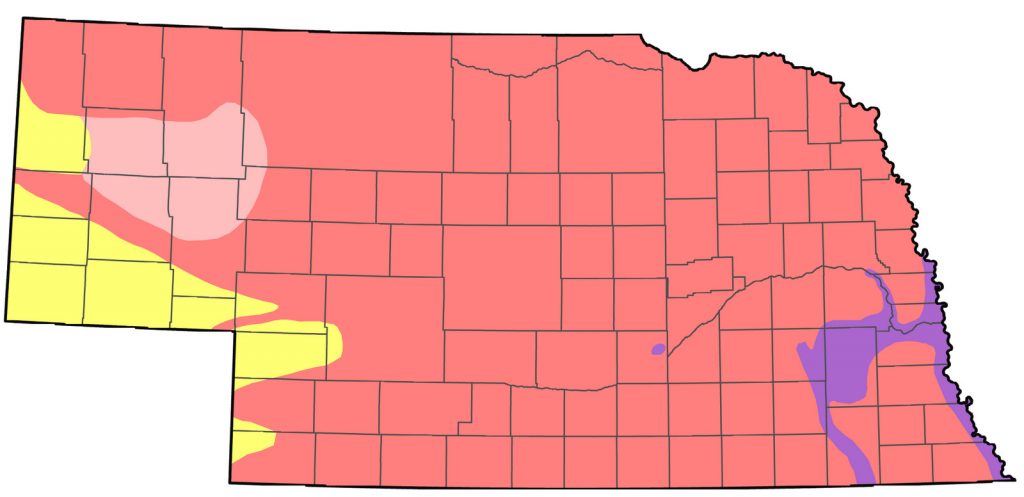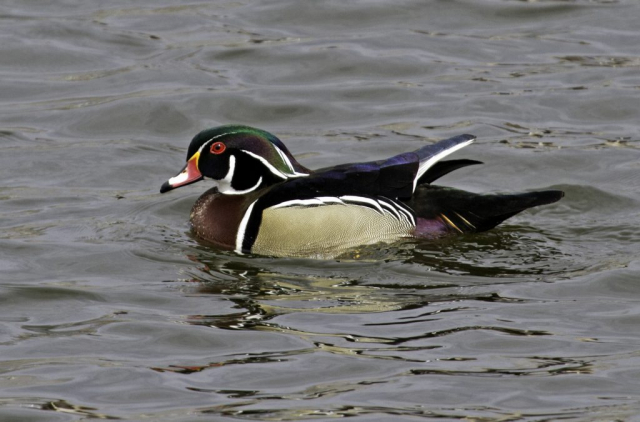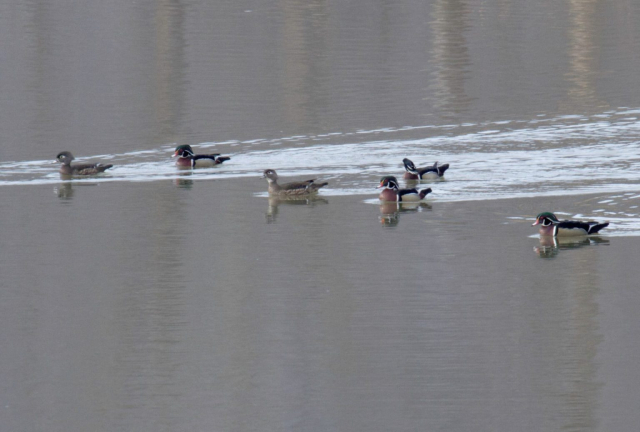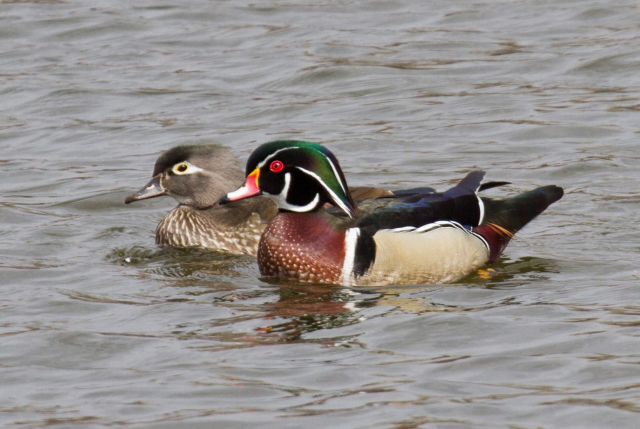Aix sponsa
Status: Common regular spring and fall migrant east, fairly common west. Common regular breeder east and central, uncommon west. Rare regular winter visitor south and east, rare casual north and west.
Documentation: Specimen: WSC 33, Oct 1971 Antelope Co.
Taxonomy: No subspecies are recognized (Avilist 2025).
Spring: winter <<<>>> summer (south and east); Mar 3, 4, 6 <<<>>> summer (north and west)
See Winter for earlier dates north and west.
Arrivals are concentrated in mid-Mar, coincident with the spring thaw; numbers peak mid-Mar through mid-Apr.
- High counts: 100 at Fontenelle Forest, Sarpy Co 17 Mar 2013, 84 at Cunningham Lake, Douglas Co 24 Mar 1996, 78 at DeSoto NWR, Washington Co 10 Apr 2021, 76 at Cunningham Lake 17 Mar 2025, and 67 at North Platte NWR, Scotts Bluff Co 16 Apr 1997.
Summer: The number of Wood Ducks breeding in Nebraska has increased markedly, primarily westward, continuing a trend that began in the 1970s; Rosche (1982) noted that Wood Duck had increased since 1976 in the Panhandle. Breeding densities are traditionally associated with the availability of wetlands and tree cavities for nest sites and thus numbers are highest in the east and south. Lowest densities occur in relatively treeless areas of the western Sandhills, Panhandle and Southwest. Placement of artificial nest boxes, especially during the latter part of the 20th Century, along with maturation of riparian habitat in central and western Nebraska, has contributed to the increases in numbers and expansion in range. The first reported nesting in the Panhandle was of two nests, each with nine eggs, in nest boxes 23 Jul 1983 in Scotts Bluff Co (Alice Kenitz; Mollhoff 2022).
The species was greatly reduced by the early 1900s but is now estimated to number some 3,000,000 total individuals (Baldassarre 2014). BBS trend analysis for Nebraska shows a 6.26% (95% C.I.; 3.32, 9.26) increase 1966-2015 and a 7.40% (95% C.I.; 0.64, 15.53) increase 2005-2015 (Sauer et al 2017).
Most Wood Ducks breed at one year of age, but late nesting in the prior year may delay maturity and result in a skipped breeding season; this scenario may account for large numbers of apparent non-breeders in Jun, such as the 153 at Verdel Landing, Knox Co 2 Jun 2019. Earliest broods appear in early May, and flight is not achieved in Nebraska broods until mid-Jul.
- High counts: 194 at Jack Sinn Memorial WMA, Lancaster Co 15 Jul 2012, 153 at Verdel Landing, Knox Co 2 Jun 2019, 100 at Crystal Lake, Dakota Co 29 Jul 2025, and 98 at North Platte NWR, Scotts Bluff Co 17 Jul 1995.
Breeding phenology:
Courting: 23 Mar
Inspecting nest sites: 10 Apr- 16 May
Incubation: 13- 14 Apr
Copulation: 13 Apr
Eggs: 5 May-23 Jul (Mollhoff 2022)
Broods: 30 Apr-22 Aug.
Fall: summer <<<>>> winter (south and east); summer <<<>>> Dec 3, 3, 3 (north and west)
See winter for later dates north and west.
Flocks form in Aug as juveniles mature, such as the 74 at Crystal Cove Lake, Dakota Co 14 Aug 2024, 67 at Glenn Cunningham Lake, Douglas Co 2 Aug 2023, 60 at North Platte WTP, Lincoln Co 1 Aug 2023, and 60-65 at Box Butte Reservoir, Dawes Co 12-22 Aug 1994. Departure dates are clustered in Oct, although individuals straggle into early Jan away from wintering areas. See Winter.
- High counts: 417 near Neligh, Antelope Co 20 Oct 2020, 228 at Milford, Seward Co 2 Nov 2023, 143 at Glenn Cunningham Lake, Douglas Co 14 Sep 2022, 118 at a Butler Co wetland 28 Aug 2020, 117 at North Platte NWR 30 Oct 1997, 109 there 10 Sep 1998, and 107 at 234th St Wetlands, Douglas Co 15 Oct 2017.
Winter: Wood Ducks rarely overwinter, but individuals occasionally can be found with wintering ducks and geese on available open water at reservoirs and parks, usually in the south and southeast. Numbers have been increasing in recent years; in winter 2024-2025 (Dec-Feb), a total of 115 were reported, including four in Scotts Bluff Co, where less than annual in winter., 48 along West Road, Buffalo Co, and 34 at Pier Park 28 Dec. Fewest reports in the south and east are from 20 Jan to 8 Feb; best counts in this period are 16 at Branched Oak Lake, Lancaster Co 6 Feb 2018, and 14 at Pier Park, Hall Co 7 Feb 2013.
Favored locations in winter include Pier Park in Grand Island, Hall Co which has hosted as many as 48 as late as 15 Dec; 10-20 winter there most winters. There are multiple records at Lakeside Park, Douglas Co, where 10 wintered 2016-2017. In Lancaster Co in 2018, as many as 16 lingered through 6 Feb at Branched Oak Lake.
In the north and west, there are few reports 3 Dec- 2 Mar: 13 Dec 2019 Scotts Bluff Co, 14 Dec 2013-11 Jan 2014 Scotts Bluff Co, 14 Dec 2021 Scotts Bluff Co, 14 Dec 2024 (4) Scotts Bluff Co, 4 Jan 2020 Scotts Bluff Co, 9 Jan 2006 Morrill Co, 11 Jan-15 Feb 2003 Scotts Bluff Co, 21 Jan 2011 (two locations) Broken Bow, Custer Co, 3 Feb 1985 Boone Co, 14 Feb 2015 Scotts Bluff Co, 21 Feb 2011 Garfield Co, 2 Feb 2015 Stanton Co, and 27 Feb 2018 Antelope Co.
Images
Abbreviations
BBS: Breeding Bird Survey
CBC: Christmas Bird Count
NWR: National Wildlife Refuge
WMA: Waterfowl Management Area (State)
WSC: Wayne State College
Literature Cited
AviList Core Team, 2025. AviList: The Global Avian Checklist, v2025. https://doi.org/10.2173/avilist.v2025.
Baldassarre, G. 2014. Ducks, Geese, and Swans of North America. Johns Hopkins University Press, Baltimore.
Mollhoff, W.J. 2022. Nest records of Nebraska birds. Nebraska Ornithologists’ Union Occasional Paper Number 9.
Rosche, R.C. 1982. Birds of northwestern Nebraska and southwestern South Dakota, an annotated checklist. Cottonwood Press, Crawford, Nebraska, USA.
Sauer, J.R., D.K. Niven, J.E. Hines, D.J. Ziolkowski, Jr, K.L. Pardieck, J.E. Fallon, and W.A. Link. 2017. The North American Breeding Bird Survey, Results and Analysis 1966 – 2015 (Nebraska). Version 2.07. USGS Patuxent Wildlife Research Center, Laurel, Maryland, USA.
Recommended Citation
Silcock, W.R., and J.G. Jorgensen. 2025. Wood Duck (Aix sponsa). In Birds of Nebraska — Online. www.BirdsofNebraska.org
Birds of Nebraska – Online
Updated 19 Aug 2025



